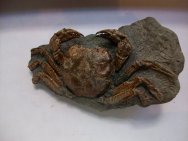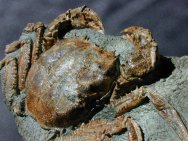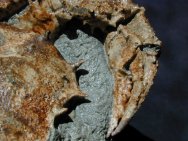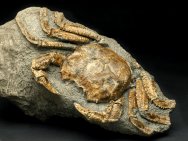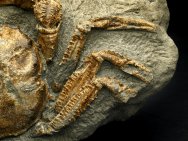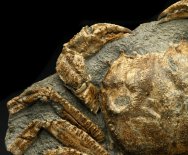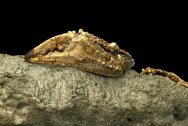| 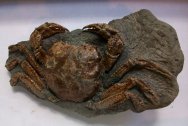 Description:
Avitelmessus grapsoideus is one of the best-known fossil crabs in
the world, but rarely if ever found in this condition! Most specimens
are of relatively poor quality, with little detail, and are best
known from the Ripley formation. This particular specimen is from
the same formation as the type specimen described by Rathbun early
in the century, the PeeDee formation of North Carolina. At a whopping
67 million years old, this specimen was found in a small quarry
alongside numerous other cretaceous fauna including remains of large
reptiles, actual dinosaurs, ammonites, and echinoids. Virtually
the entire coastal ecosystem was represented. Description:
Avitelmessus grapsoideus is one of the best-known fossil crabs in
the world, but rarely if ever found in this condition! Most specimens
are of relatively poor quality, with little detail, and are best
known from the Ripley formation. This particular specimen is from
the same formation as the type specimen described by Rathbun early
in the century, the PeeDee formation of North Carolina. At a whopping
67 million years old, this specimen was found in a small quarry
alongside numerous other cretaceous fauna including remains of large
reptiles, actual dinosaurs, ammonites, and echinoids. Virtually
the entire coastal ecosystem was represented.
Specimens of this quality are extremely rare with only a few existing
in private or public collections. Of those few, this is one of,
if not, the single, best this writer has ever seen (very hard matrix-
this is a superior preparation). Our ace preparator, Rod Bartlett
of B.C. Canada invested 60 hours of meticulous air abrasion into
this masterpiece. Many partial specimens from the now lost site
(currently a bass stocked lake) were used in several recent publications
describing primary and secondary sexual characteristics and other
features of this species almost never seen preserved even in much
much younger species such as those famous specimens from Italy (usually
composites, incidentally- not so this ancient specimen)
Covered "head to toe" in spikes, spines, and pustules,
this specimen looks as if it could get up and walk off of the matrix.
Specimens like this are likely never to be seen again, and this
specimen would enhance any collection, public or private. In fact,
museums around the globe are clambering for one of these to add
to their collections (though enough information has been gather
from partial specimens to make this one of the better understood
fossil families in history!) In life, like crabs of now, those spines
and bumps served as anchor points for sponges, algae’s and
the like to help in the camouflage of this unique animal. One can
imagine it was probably not very appetizing to swallow with the
longer spines as well (although, clearly bitten partial specimens
were uncovered during the existence of the quarry.)
Interestingly, the species is known to have ten legs, of course,
but the rear most legs are almost never found intact on any specimen
from anywhere- it is assumed they are extremely reduced relative
to the remaining legs- a feature of this crab’s family, the
dakotacancridae.
This crab was preserved in what we have found must have been a catastrophic
burial (e.g., localized underwater slide or hurricane event.) All
the fossils found are found in relatively very shallow lenses in
the Peedee of North Carolina, and a very small arial range.
Very definitely an "investor" grade fossil. If we didn't
happen to be in possession of another of the three known of this
quality in our private collections, there is no way this would be
made.
|

